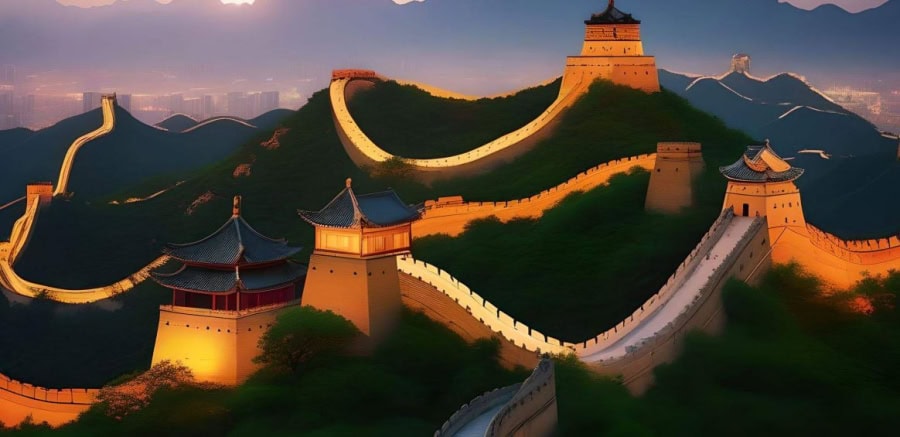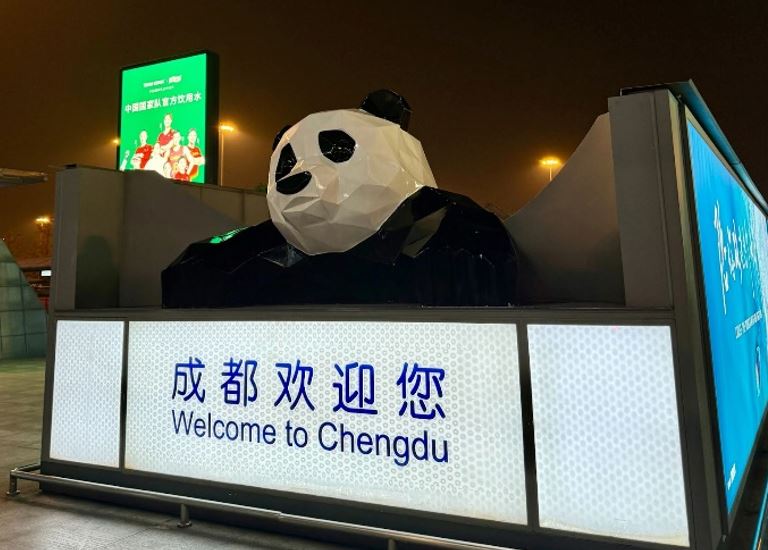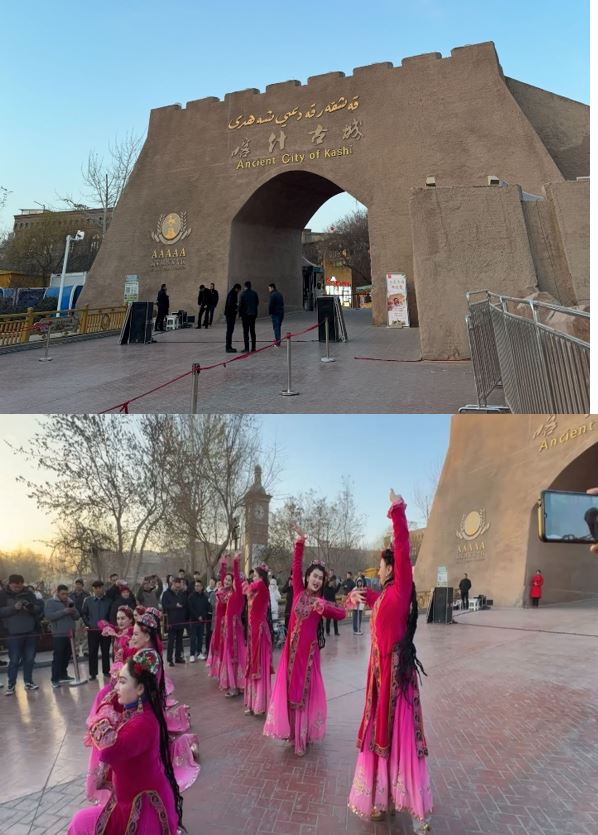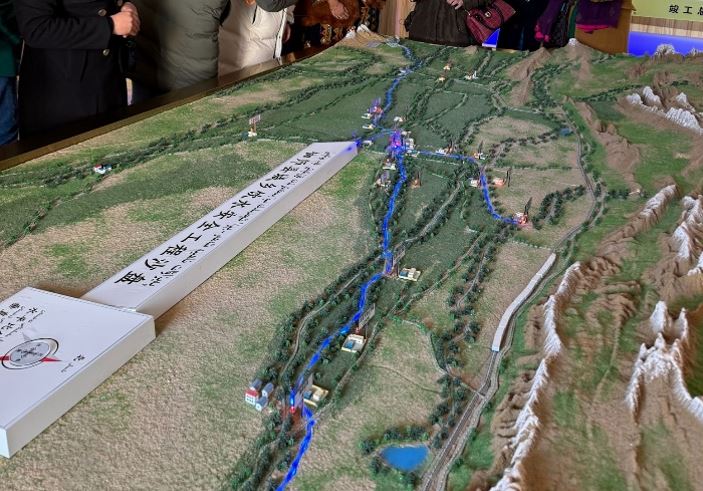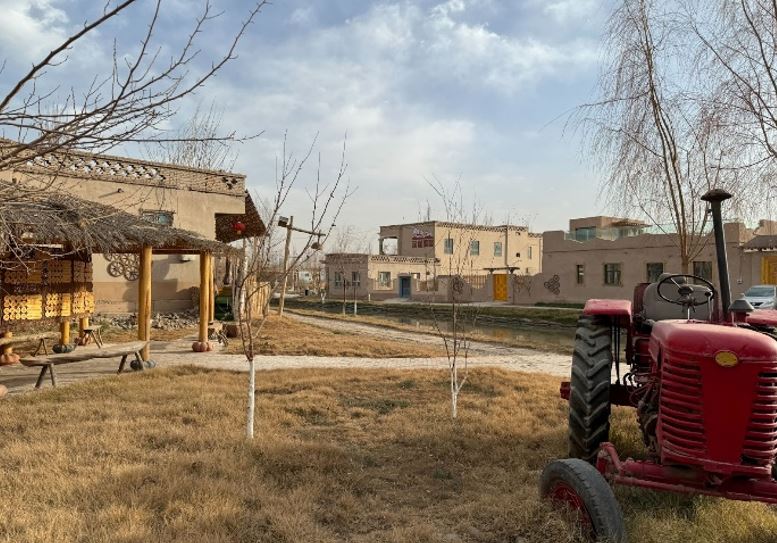As our Pakistani media delegation embarks on this eye-opening 10-day expedition across China, we’ve encountered a nation that defies the misconceptions pushed by Western media. Our journey spanning Beijing to Chengdu, Kashgar, and Urumqi has revealed a vibrant country with a rich cultural heritage, groundbreaking technological strides, and a solid commitment to shared prosperity.
The deeper I delve into China’s narrative, the more obvious it becomes how poorly it’s understood in the West. The recent surge in anti-China propaganda, coinciding with the rise of a US-led New Cold War, has painted an intimidating image of China as some sort of authoritarian threat seeking global dominance. Regrettably, many have believed these disgraceful reports propagated by the media, embracing false narratives regarding human rights suppression in Xinjiang and beyond.
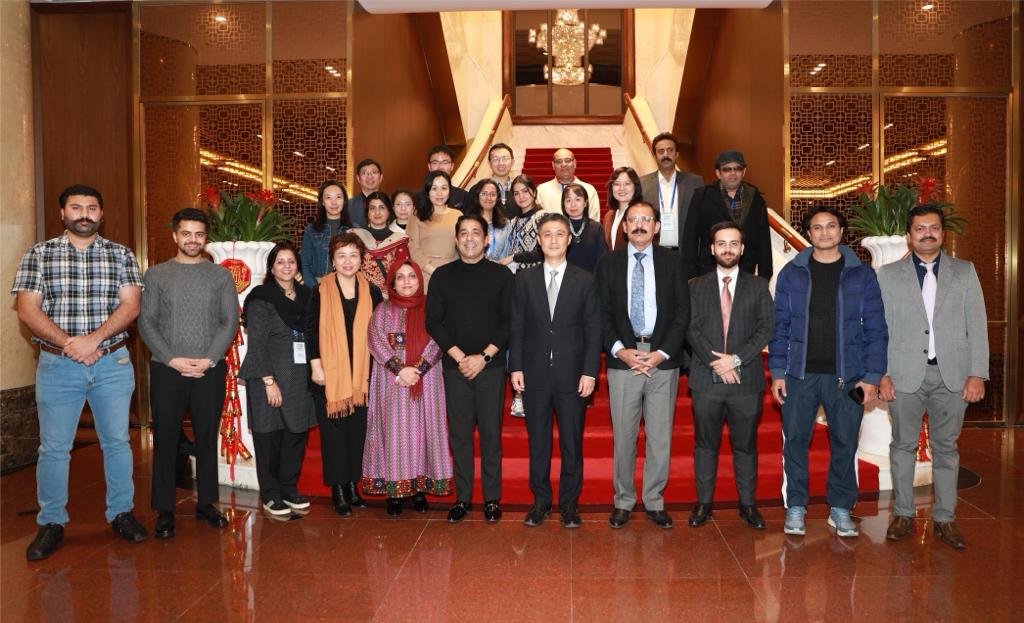
Yet, how do we reconcile these notions with China’s monumental achievements? It has elevated living standards to unprecedented heights, emerged as the globe’s renewable energy frontrunner, transcended from poverty to a technological powerhouse, steered the world towards multipolarity, and now boasts a higher life expectancy than the US. These milestones indicate historic progress unparalleled by any capitalist nation.
Our media delegation sought to witness this truth firsthand, to peel back the layers of misinformation and delve into the realities of China’s progress. We aimed to investigate the human narratives beneath the statistics to understand the lives transformed by these remarkable advancements.
In this exploration, we learn invaluable lessons for Pakistan, a nation grappling with challenges similar to China’s past struggles – poverty, healthcare, technology, and development. China’s trajectory serves as a beacon, inspiring a path towards eradicating poverty, utilising technological advancements, and prioritising public health.
Beijing: Beyond the Great Wall
The chilly winter air of Beijing welcomed us as we, a delegation of seasoned Pakistani media representatives, stepped onto its historic land. It was the 6th of December, a day marked in our calendars not just as a date but as the beginning of a revelatory journey.
Huaneng Clean Energy Research Institute: A Beacon of Modernisation
Our first destination, the Huaneng Clean Energy Research Institute, was not just a location but a solid reminder of China’s commitment to sustainable energy. Upon arrival, their Vice-President who warmly greeted us, who later graciously gave us a tour of their facility. This institute, a champion in the field of clean energy, demonstrated China’s dedication to an eco-friendly future. Their philosophy, deeply rooted in the ‘Three-color’ corporate mission, showcased a blend of economic advancement, political responsibility, and social welfare.
As we toured the facility, the strategic positioning of the institute became clear. Their focus on ‘Three Colors, Three Strongs, and Three Excellence’, with power at its core, innovation as its guiding force, and a global reach, was impressive. The narrative of China being at the forefront of the worldwide energy transition was noticeable here. The institute’s role in ensuring national energy security and promoting sustainable economic development resonated with our understanding of a responsible global power. Upon leaving, we learned that HCERI was the first among Chinese power generation enterprises to join the ranks of the Fortune Global 500.
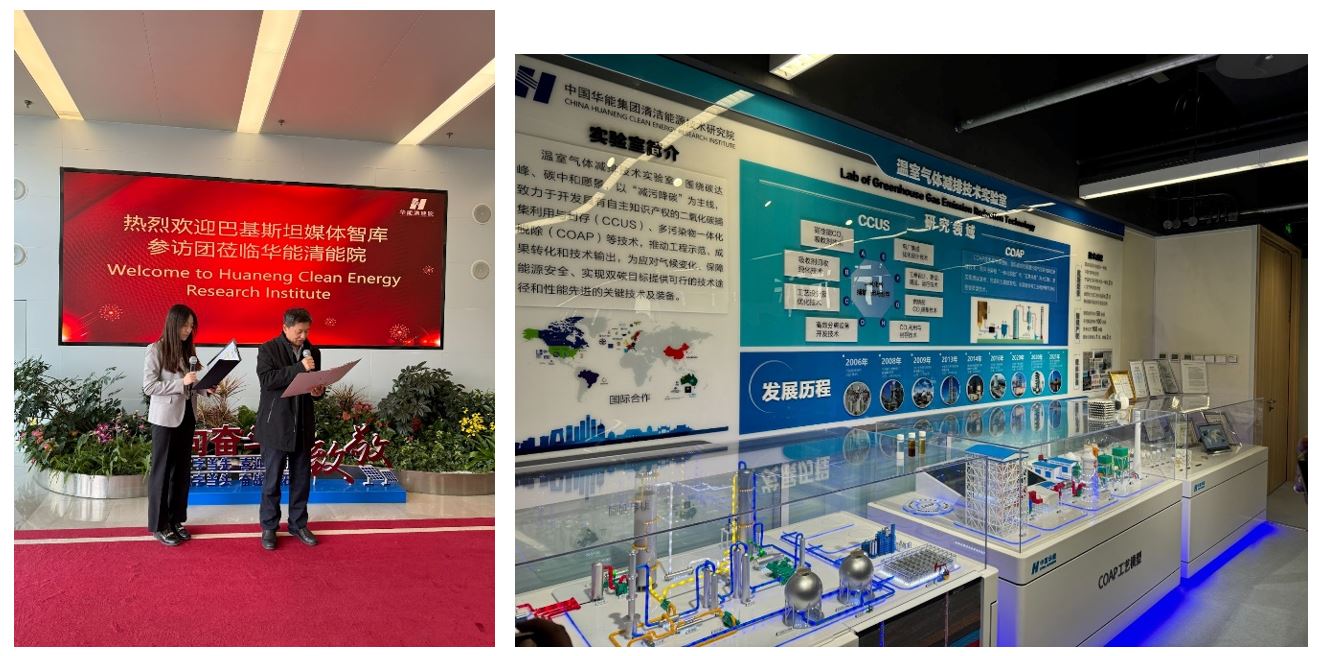
Journey to the Great Wall: A Walk Through History
The afternoon took us to a marvel of human perseverance and creativity – the Great Wall of China. Stretching over 20,000 kilometres, this colossal structure is a testament to China’s historical resilience. Walking along the wall, we were deeply curious. We are fascinated by tracing the steps of countless souls who built and walked this path over two millennia.
Our delegation leader, Liu Chang, who echoed an ancient Chinese saying, “He who doesn’t reach the Great Wall is no hero.” We all felt energised and captivated by immersing ourselves in this world-wonder. Even while writing this, I still think about the countless years it took to build and fortify this grand project, imagining the workers going through steep hills and doing their jobs. It also made me think of the great pyramids of Giza, another marvel of architecture that still puzzles modern-day scientists and architects.
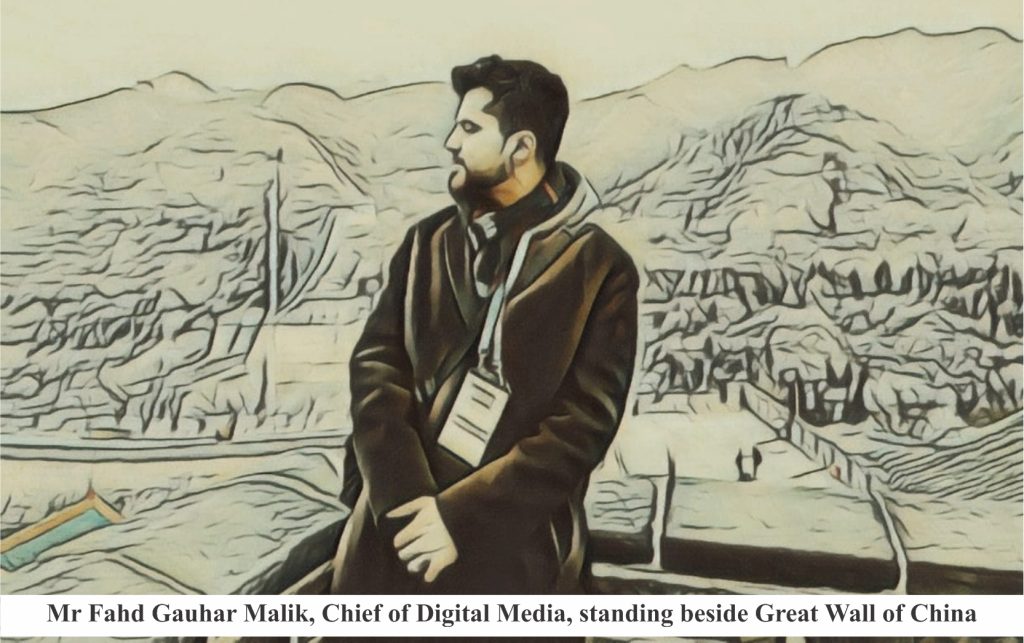
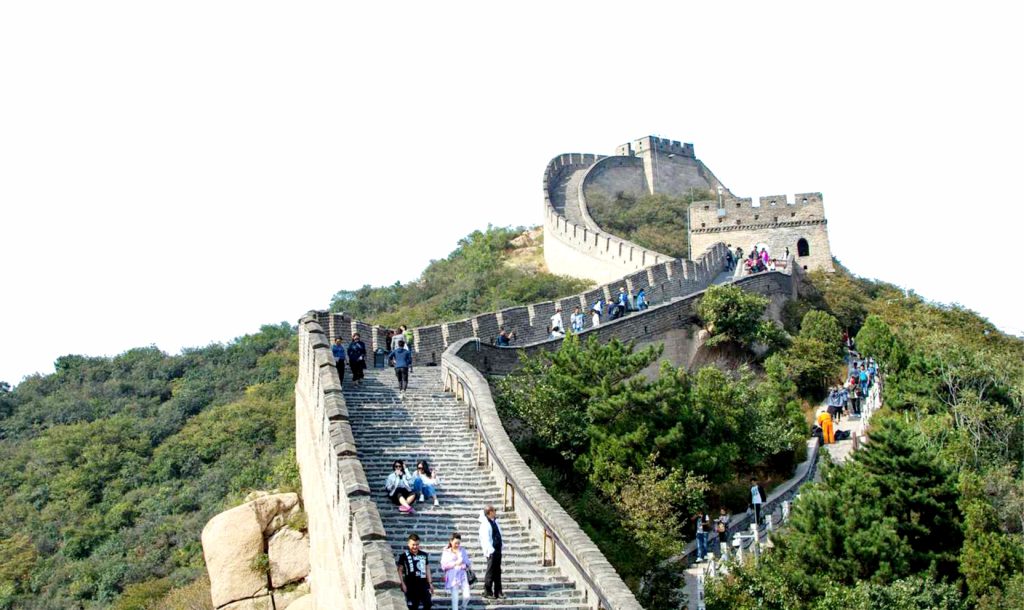
Shougang Park: A Symphony of Past and Future
Our next stop, Shougang Park, was a marvel of urban rejuvenation. Once the heart of China’s steel production, this site had transformed into an emblem of sustainable urban development. As we strolled through the park, remnants of its industrial past, like towering blast furnaces and smokestacks, stood as silent witnesses to history.
The park’s transformation was a story of vision and determination. In the face of environmental challenges, Beijing had chosen a path of renewal and reinvention. Once contributing to pollution, the site thrives as a green, cultural, and sports hub.
The highlight was the Big Air Shougang, a structure of architectural wonder. Resembling a high-heeled crystal shoe, its towering ramp was a symbol of Beijing’s innovative spirit. Here, athletes soared through the air, performing breathtaking aerial feats during the Beijing 2022 Winter Olympics. This venue, capable of hosting over 8,000 spectators, was not just a sports facility but a symbol of China’s ability to reimagine and repurpose its industrial past for a brighter, greener future.
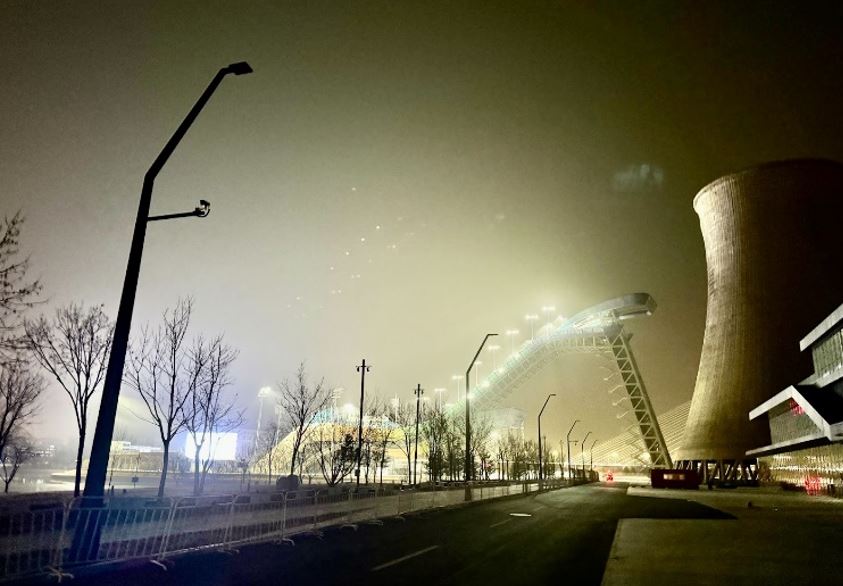
From the innovations at the Huaneng Institute to the historical magnificence of the Great Wall and the transformative genius of Shougang Park, Beijing has revealed its multifaceted character. It was a narrative far removed from the Western media’s portrayal. It was one of a nation deeply rooted in its heritage yet boldly marching towards a future of sustainable and inclusive growth.
In Beijing, history wasn’t just remembered; it was lived. And as we looked forward to the days ahead, we knew this was just the beginning of our journey to uncover the true essence of China.
Beijing’s Innovation Journey: A Day of Discovery and Friendship
Our journey on December 7th began under the clear, blue skies of Beijing, heading towards the city’s renowned Economic-Technological Development Area. This place, an energetic hub of innovation, felt like stepping into the future.
The E-Commerce Giant: JD.com
Our first encounter was with the digital giant JD.com. As we strolled through their vast complex, it felt like we were walking through the pages of a science fiction novel, yet it was all real. The story of JD.com’s rise from its humble beginnings in 2004 to a powerhouse in e-commerce was not just impressive; it was inspiring.
Their commitment to technology was palpable. We learned about their staggering investment in R&D, a whopping 100 billion yuan, transforming them into a behemoth of supply chain-based technology and services. What struck me most was their philosophy of a “responsible supply chain.” It wasn’t just about selling products but about creating a sustainable and efficient ecosystem that benefits everyone involved.
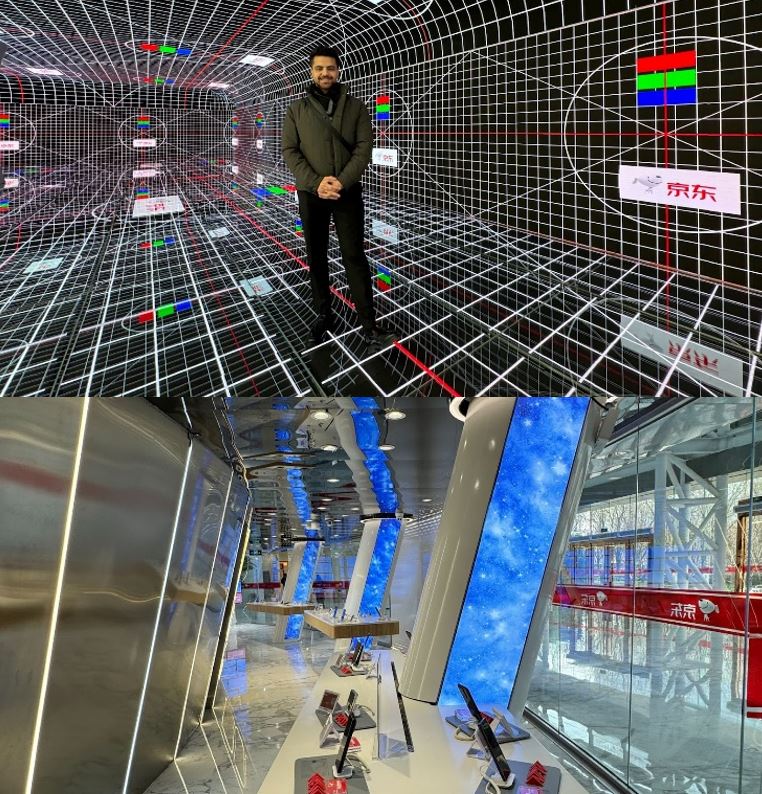
The Future on Wheels: Baidu’s Apollo Park
Next, we were off to Apollo Park by Baidu. Known for leading the autonomous driving revolution, Apollo Park presented us with the future of transportation. Baidu’s journey from deploying autonomous driving technology in 2013 to creating the world’s first open platform for autonomous driving in 2017 was remarkable.
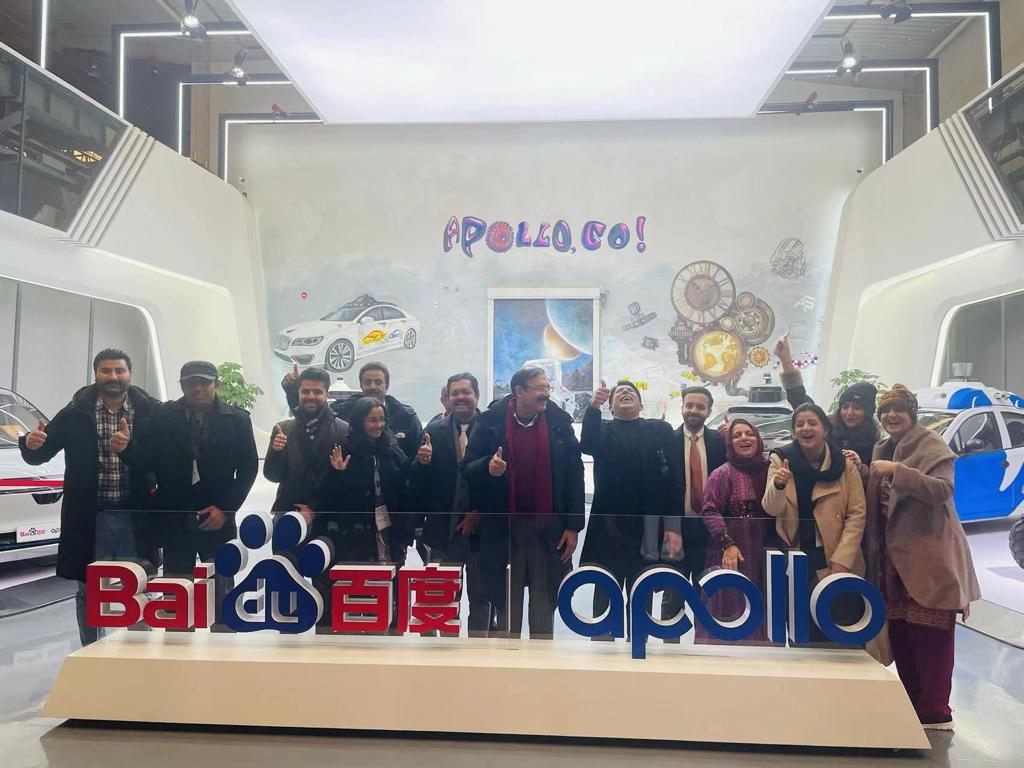
We got to experience the magic of autonomous driving at Baidu’s Apollo Park. There was a collective gasp when we stepped into one of their self-driving cars. The thought of a car navigating the crowded streets of Beijing without a driver was something we had only imagined. It was both thrilling and a bit nerve-wracking, but the smooth ride and the car’s intelligent responses to traffic amazed us all. It was a moment where the future felt now.
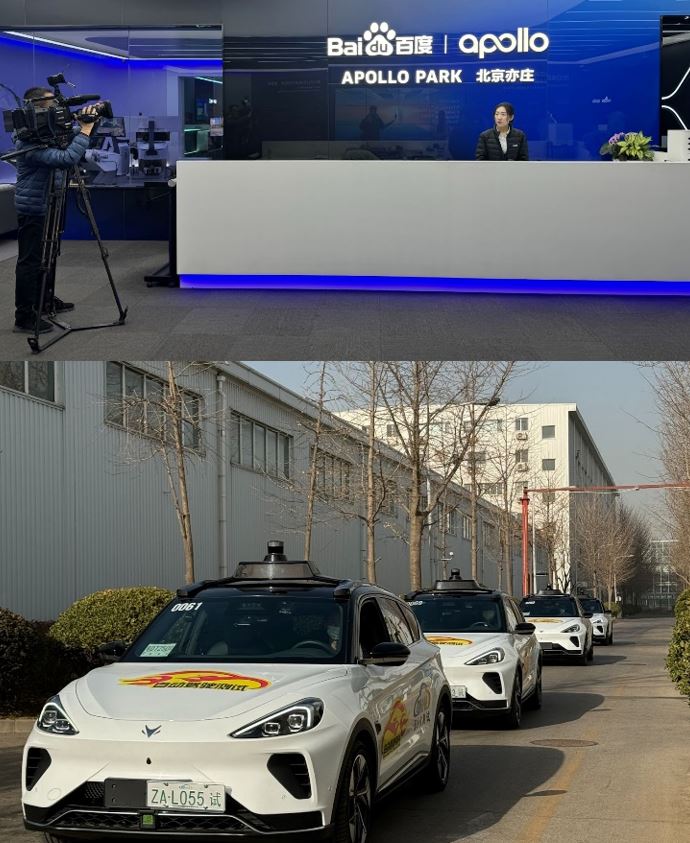
Engaging in Discussions at the Chinese Social Sciences Academy
Our afternoon was spent in the esteemed halls of the Chinese Academy of Social Sciences (CASS). Here, we were not just visitors but learners, soaking in knowledge from some of the brightest minds in China. Professor Dr Li Xiangyang’s warmth and wisdom made us feel at home. His acknowledgement of the Pakistan-China friendship was touching, reminding us that our nations’ bond went beyond just politics; it was about people, understanding, and shared dreams.
We were extremely happy to know that the professors have been in touch with universities and think tanks from Pakistan, and were also informed that last time when Dr Ahsan Iqbal, Federal Minister of Planning and Development, visited China, they had a very fruitful and essential discussion regarding CPEC projects in Pakistan.
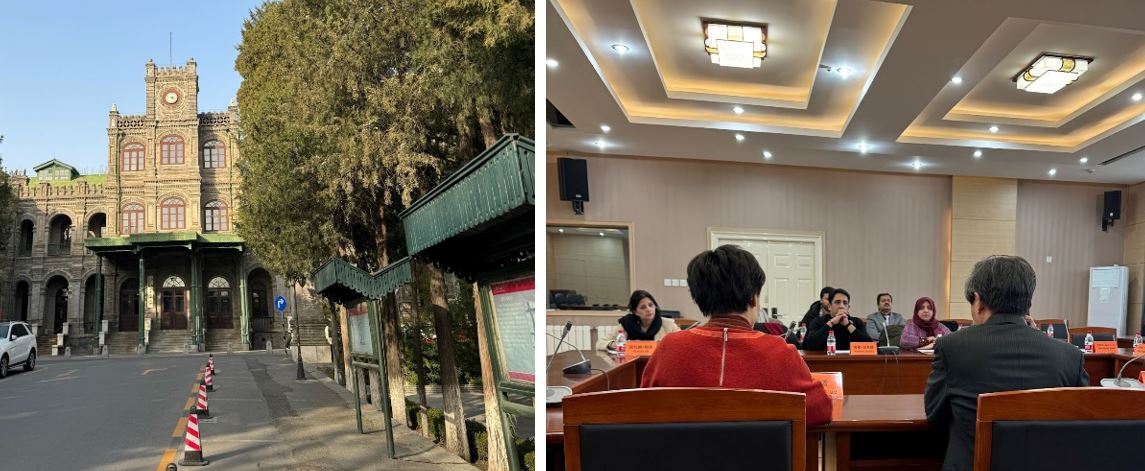
Visit to Economic Daily: Strengthening Media Ties
Our day concluded at the headquarters of Economic Daily, China’s most significant economic media a platform. The warm welcome by Ms Tang Weibin, Mr Wu Li, Mr Cui Jun, and Mr Zhu Lei exemplified the deep-rooted friendship between Pakistan and China. Ms. Tang Weibin, Deputy-Editor-in-Chief of the Economic Daily, gave a heartwarming speech on enhancing media cooperation. It was not just rhetoric but a commitment to a shared future. We got to see previous interactions of ED with fellow Pakistani media persons and special reports they had published in line with their cooperation policies.
The visit to Economic Daily symbolised more than a media interaction; it reaffirmed the bilateral ties that have stood the test of time. It was a moment of reflection on how media can play a pivotal role in shaping perceptions and fostering mutual understanding. I was deeply fascinated by the scope and technology used at their headquarters, where a large cinema-sized screen was visible at the writers’ desk, displaying different statistics and news stories uploaded in real time. Upon asking the hosts about the dashboard, we were informed that more than 500 stories are published daily, which is why such a detailed monitoring system is needed for this platform.
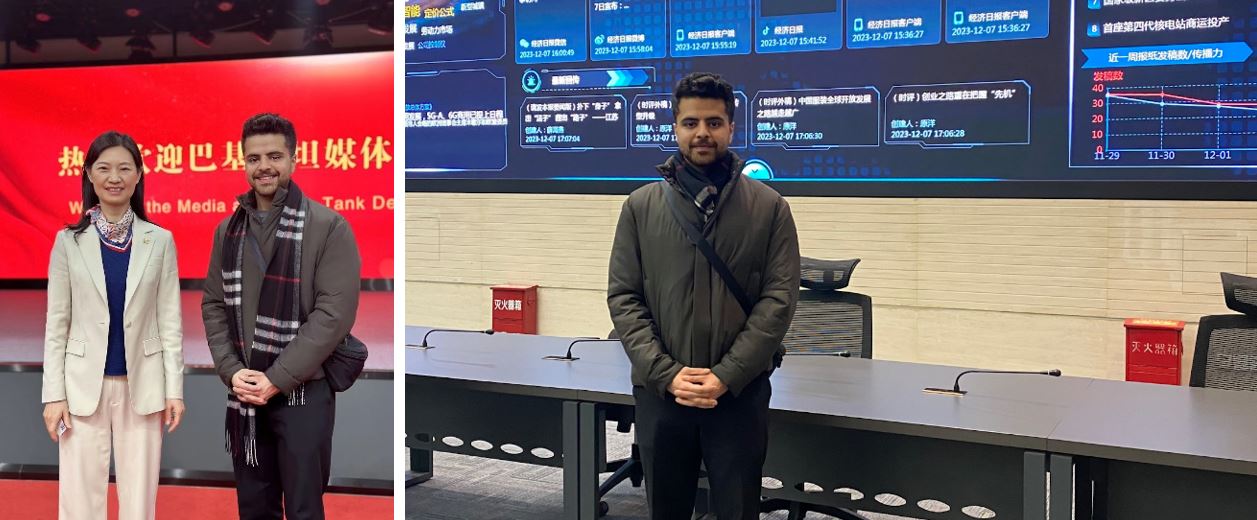
As the day drew to a close, and we headed back to our hotel, our minds were buzzing with the day’s experiences. The technological wonders at JD.com and Baidu, the intellectual richness at CASS, and the warm interactions at Economic Daily have given us a new perspective on China.
Beijing has shown us its heart – one that beats not just for technological advancement but for sustainable development, cultural understanding, and deep-seated friendships. This city, and indeed this country, was a global player in innovation and economics and a place where relationships and human connections flourished.
Historical and Modern Marvels in Beijing
A Journey through Time: The Forbidden City
December 8th greeted us with a clear Beijing sky, under which lay our first destination: the majestic Forbidden City.
Stepping into this sprawling palace complex, I felt we had travelled back in time. The sheer scale of it was larger than 50 Buckingham Palaces combined. Walking through the ancient halls and courtyards, we were surrounded by the most extensive collection of preserved ancient wooden structures in the world, a title duly recognised by UNESCO.
As we wandered the same paths where emperors once walked, it was impossible not to feel humbled by the history surrounding us. The Forbidden City wasn’t just a place but a chronicle of Imperial China, frozen in time. The walls and artefacts whispered stories of emperors, court life, royalty, and solitude. Atop the Gate of Heavenly Peace, it was here that Mao Zedong declared the founding of the People’s Republic of China in 1949 is a testament to the site’s enduring significance in Chinese history.
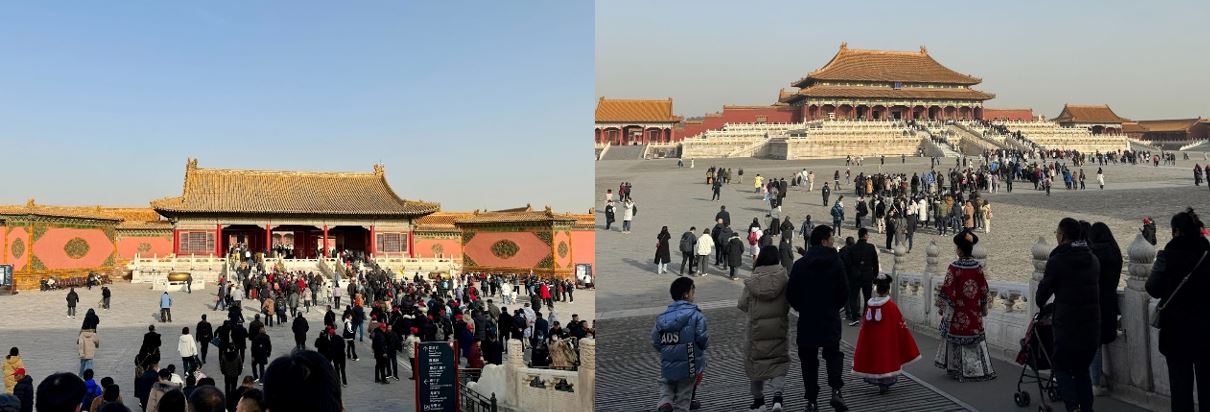
The Modern Marvel: Beijing Daxing International Airport
From the echoes of the past, we journeyed to a marvel of modern engineering – the Beijing Daxing International Airport. Accessing it via the Beijing Subway Airport Express added another layer to our experience, seamlessly blending modern transit with the city’s landscape.
Upon arrival, the airport’s starfish design immediately captivated us.
The convergence of the five mega terminals into a central hall mirrored traditional Chinese architectural principles, where interconnected spaces revolve around a central courtyard. This wasn’t just an airport but a beautiful combination of design and functionality. I was most amazed at the pillar-less walls throughout the mega airport. We could not see any straight pillars holding down the structure, which was incredible.
The terminal, covering an astonishing 7.5 million square feet, was a testament to China’s ambition and foresight. The airport’s ground transportation centre, linking directly to Beijing, the national high-speed rail, and local trains, highlighted China’s commitment to connectivity and economic development, extending its benefits to Tianjin and Hebei Province. This airport is projected to be the busiest airport in the world in 2040 and can carry more than 70 million passengers in total capacity.
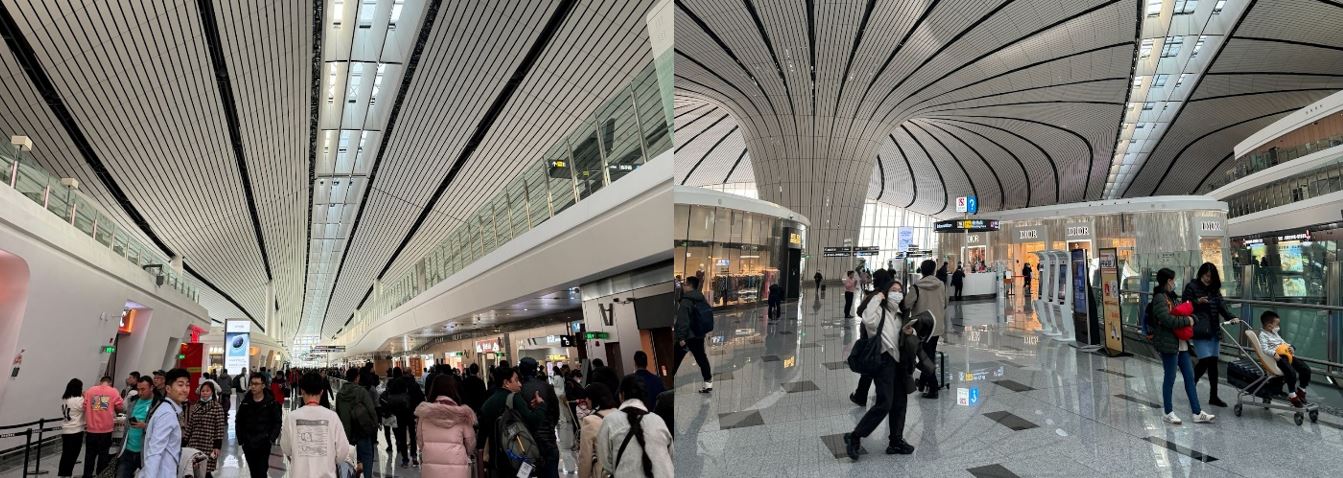
Lessons for Pakistan: Bridging Past and Future
Reflecting on these visits, I realised that Pakistan could draw valuable lessons from China’s harmonious blend of preserving the past while embracing the future. The Forbidden City taught us the importance of cherishing our heritage of making our history accessible and relevant to future generations. It’s a reminder that our historical sites are not just tourist destinations but custodians of our collective memory.
Beijing Daxing International Airport, on the other hand, represents a vision for the future. It demonstrates how thoughtful design and infrastructure can meet current needs and anticipate and drive future growth. For Pakistan, investing in such visionary projects could catalyse economic development and position us as a critical player in the global arena.
The Chronicles of Chengdu
Arrival in Chengdu: The City of Abundance
As our plane descended into Chengdu, the capital of Sichuan province, a different facet of China unfolded before us. Upon checking into the historic Jinjiang Hotel, I couldn’t help but feel the city’s unique blend of ancient charm and modern vibrancy. Chengdu, with a history spanning over 3,100 years and a name unchanged for more than two millennia, presented itself as a living museum of Chinese culture and advancement. Regarded as one of China’s most livable cities, there is something for everyone in this booming capital of Sichuan province.
A Glimpse into the Future: Chengdu Urban Planning Museum
Our first stop, the Chengdu Urban Planning Museum, offered a fascinating journey through the city’s evolution. Starting from its ancient roots and moving towards its ambitious future, the exhibits encapsulated Chengdu’s aspirations and achievements. Unlike Beijing, which has been known by over 20 different names across dynasties, Chengdu’s consistency in its name is a remarkable tale in itself – a symbol of its enduring identity amidst the tides of time.
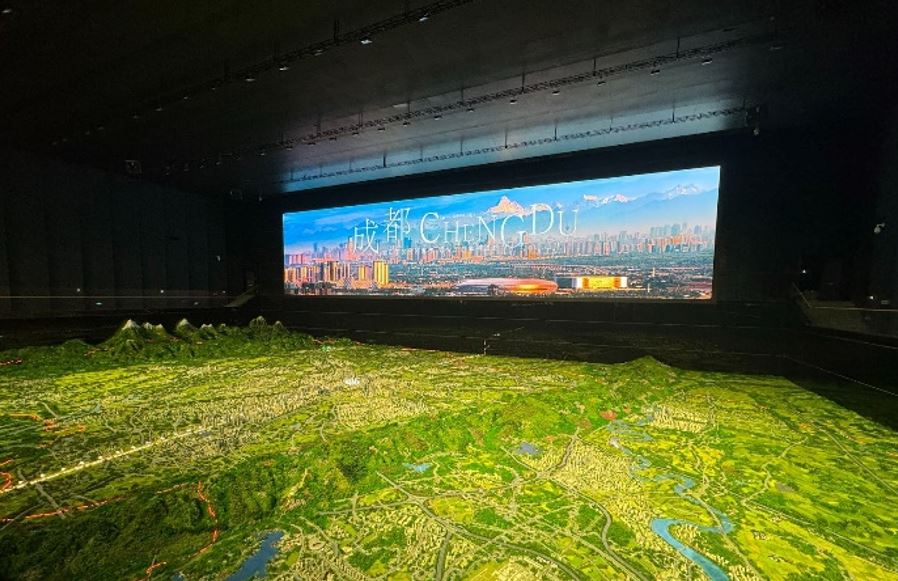
Qingbaijiang District: A Hub of Connectivity
Our visit to Qingbaijiang District, home to the Chengdu International Railway Port, was an eye-opener. The district’s transformation from an old industrial zone to an international transport hub underlines the dynamic nature of modern China. Witnessing the busy activity at the port, which plays a crucial role in the Belt and Road Initiative, I was struck by the sheer scale of ambition and execution. The impressive statistics – over 4,700 trips by the China Railway Express (Chengdu) in 2022 alone – were a testament to the district’s pivotal role in global trade.
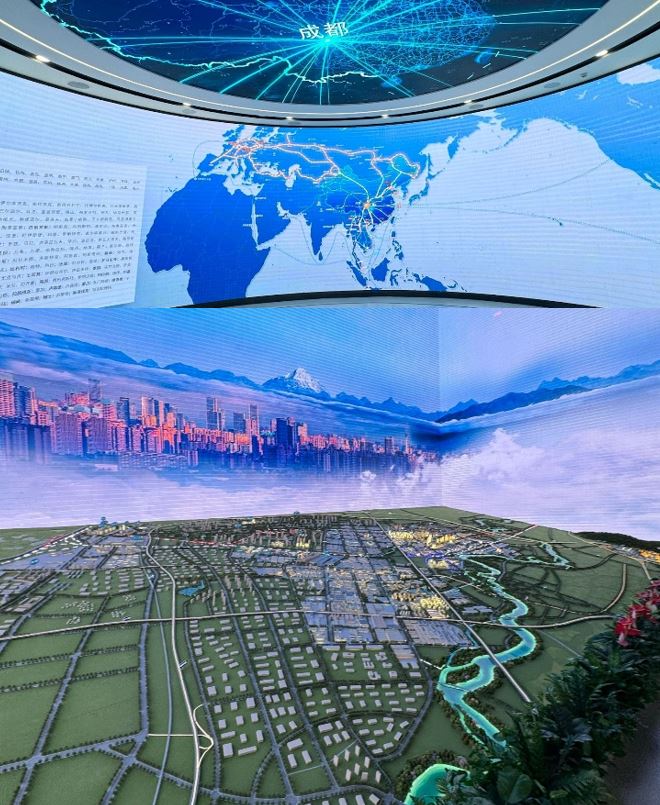
The Pavilion of Global Harmony: Chengdu-Eurasia National Pavilion
Perhaps the most vivid illustration of Chengdu’s international aspirations was our visit to the Chengdu-Eurasia National Pavilion. This giant complex, with pavilions from countries along the Belt and Road, including Pakistan, was a celebration of global harmony and cooperation. Walking through these pavilions, each showcasing the unique culture and products of its respective country, felt like a quick tour of the world. It was a powerful symbol of Chengdu’s vision to be a melting pot of international cultures and economic partnerships.
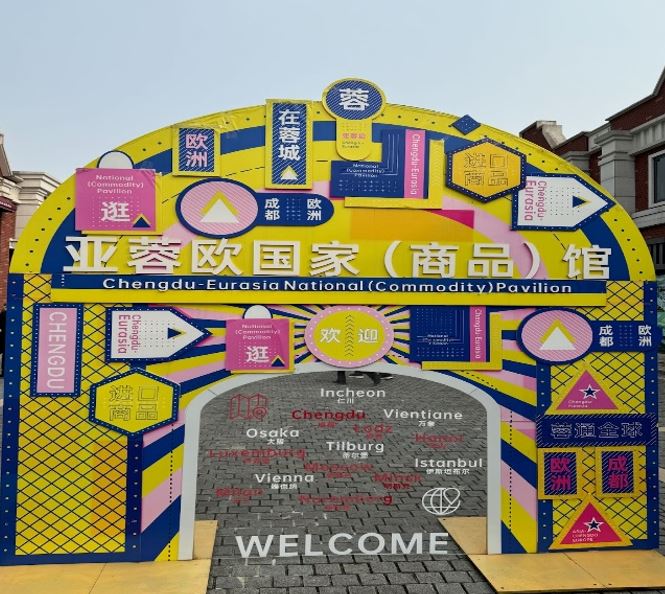
Kuanzhai Alley, Spice and Everything Nice:
Our day concluded with a stroll through Kuanzhai Alley, a charming testament to Chengdu’s rich history. The three parallel alleys – Wide, Narrow, and Well – each had their unique flavor, offering a glimpse into the city’s soul. From the well-preserved Qing Dynasty buildings to the lively street performances and local handicrafts, Kuanzhai Alley was a delightful mix of history, culture, and contemporary life.
In Chengdu, every meal is an adventure. The city’s famous spicy hot pot, infused with the renowned Sichuan peppercorn, delivers a numbing yet exhilarating taste that dances on your tongue. It’s an acquired taste, but once you’re hooked, there’s no going back.
That evening, we were treated to a traditional Sichuan Opera. The face-changing performance was nothing short of magical. The swift and seamless transformations of the performers left us spellbound. To this day, I’m still trying to figure out the secret behind this captivating art form, unique to Sichuan. It’s a mesmerizing blend of history, culture, and mystery, much like Chengdu itself.
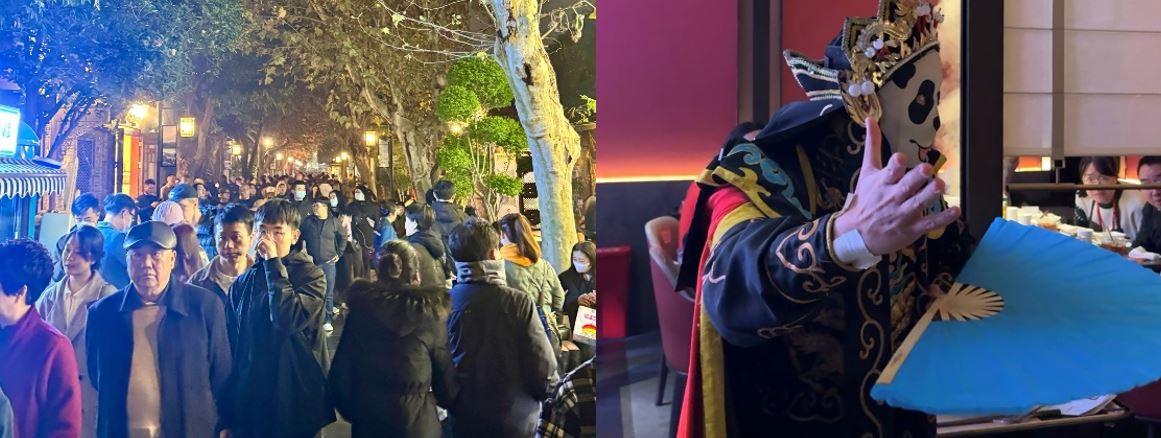
Morning Amongst the Pandas
The morning of December 10th found us heading to the Chenghua District, eager for an encounter with China’s most iconic ambassadors – the giant pandas. As we approached the Chengdu Research Base of Giant Panda Breeding, I couldn’t help but feel a sense of excitement. These pandas are not only just China’s “National Treasure”, but also they have captured the hearts of people worldwide.
The Chengdu Panda Base, a verdant sanctuary with over 96% coverage of bamboo forest, is a testament to China’s commitment to wildlife conservation. Established in 1987 with just six ailing pandas rescued from the wild, the base has grown into a haven for over 150 of these magnificent creatures. It’s a place where you can’t help but smile, watching the pandas go about their day, lounging, eating, and playing. The base, hailed as the “Cradle of Giant Pandas,” is more than a tourist attraction; it’s a symbol of hope and a successful conservation effort.
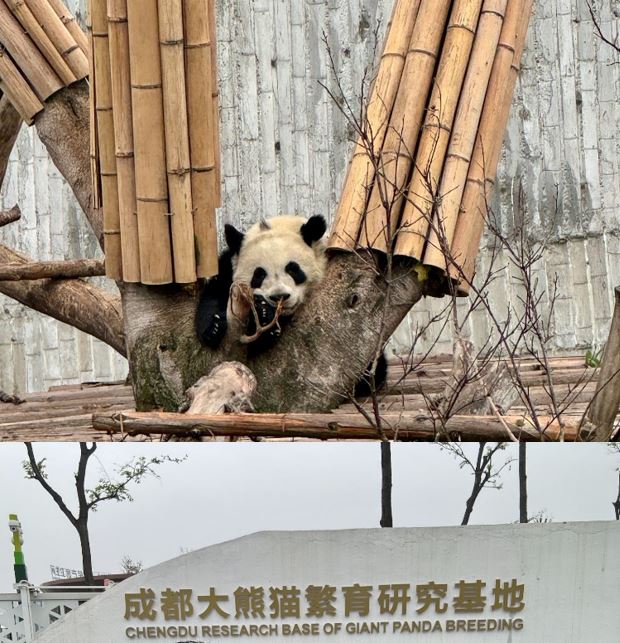
Journey to Kashgar: A City of Revelations
As we flew from Chengdu Tianfu International Airport to the storied city of Kashgar, I felt a mix of anticipation and curiosity. Known as Kashi, this ancient city promised insights into a narrative far from what has often been portrayed.
Eid-Gah Mosque: A Symbol of Religious Freedom
Our first destination in Kashgar was the Eid-Gah Mosque, an enduring emblem of Islamic heritage in China. Built in the Ming Dynasty and spanning over 550 years of history, the mosque’s majestic architecture reaching 25 acres offered a profound sense of peace. Observing Muslims freely practising their faith here was not just an eye-opener but a heart-opener, challenging the narratives of religious oppression we often hear about in the West.
The mosque, preserved through extensive renovations funded by the state, spoke volumes about respecting religious structures and practices in China. Walking through its historic halls, the allegations of religious suppression seemed more like shadows than substance.
In conversations with the Imam of Etigar Mosque, Mr. Muhammad, and local Chinese officials, a narrative starkly different from Western reports unfolded. The Imam’s testimony about living without fear or intimidation as a Muslim leader in Kashgar was compelling. His words, “The life of a lie is always short, and the truth is destined to prevail,” resonated deeply, underscoring the importance of seeking truth through personal observation and interaction.
The revelation about the 9000 mosques in Kashgar, none demolished but some renovated, and the absurdity of rumours about bans on beards and veils, painted a picture of a community practising Islam with freedom and respect.
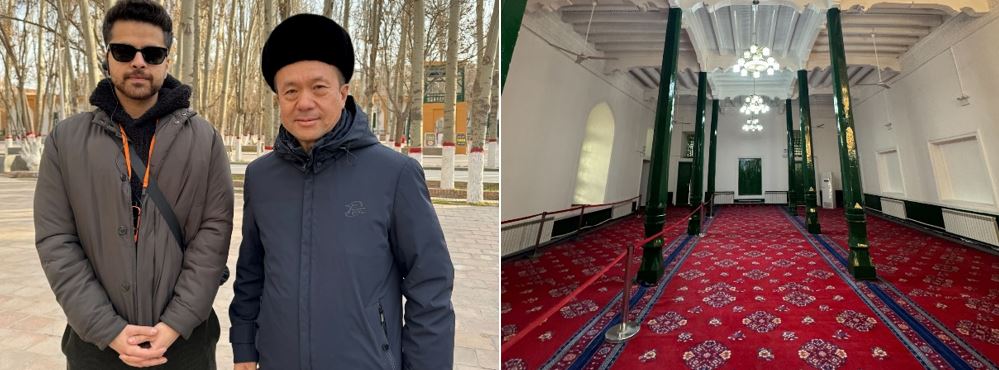
Kashgar Old City: A Living Museum
The Ancient Town of Kashi, a national 5A level scenic spot, was a journey back in time. In the Kashgar Old City Comprehensive Protection and Management Memorial Hall, we learned about the extensive renovation efforts in the Ancient Town of Kashi. The “one household, one design” approach, ensuring seismic safety while preserving ethnic architectural styles, was impressive. The project, involving an investment of over 7 billion yuan, not only maintained the city’s historical character but also significantly improved the living conditions of its residents.
UNESCO’s recognition of this effort as worthy of learning highlights its global significance.
Debunking Myths: A First-Hand Experience
The visit to Kashgar was a revelation. Contrary to the Western narratives of repression, the city was a vibrant testament to the freedom and respect afforded to the Uyghur Muslim community. The absence of the alleged surveillance and intimidation painted a very different picture from what has been portrayed in the media.
Interacting with residents and religious leaders, especially the Imam of the Etigar Mosque, further invalidated the claims of atrocities. Their testimonies, reflecting a life of peace and religious freedom, shattered the illusions created by misinformation.
Journey to Payzawat: Witnessing a Water Revolution
December 12th dawned bright and clear as our delegation departed for Payzawat County. Here, we were to witness the Gashi County Urban and Rural Drinking Water Safety Project, which was hailed as a monumental achievement in providing safe drinking water. Known as the “big drinking water reform” project, it symbolised more than just infrastructure; it was a lifeline to the people.
With a staggering investment of 1.749 billion yuan, the project has revolutionised water access in the region. Spanning three counties and connecting 13 townships, this vast network of pipes, stretching 1827 kilometres, eradicated the centuries-old plight of bitter and salty water consumption for 460,000 residents. Witnessing the grandeur of the main water plant on the east bank of the Ghazi River and understanding the scope of this endeavour, I couldn’t help but feel inspired by the commitment to ensuring the fundamental right to clean water.
Our delegation also had the opportunity to visit a family home and see their conditions, it was amazing to learn that they had all the necessities of electricity, gas, heating and safe water access. The hospitality we received, even at a poor man’s home, was grand, similar to how Pakistanis treat their guests.
Rice and Spring Village: Repurposed for the future
The day concluded with a visit to the picturesque “Rice and Spring Village” in YukalkeKakula Village. As a key national rural tourism village, it’s a vibrant showcase of how tourism can be a catalyst for rural prosperity. The transformation of the village into a scenic spot, with its extensive water system and green areas, is a testament to innovative rural development.
The village’s success in attracting over 190,000 tourists and generating significant income for locals highlights the potential of rural tourism in fostering economic growth and national unity, indirectly generating an income of more than 4 million yuan for local people. This has contributed to an average annual income increase of more than 1.05 million yuan. The employment opportunities created through this development are a beacon of hope for rural communities seeking sustainable, growth.
Reflections: Lessons for Pakistan and Beyond
As we returned from our day’s journey, the lessons from Payzawat and Daoxiangquan were clear. These projects in Xinjiang are not just about infrastructure or business; they are about transforming lives, communities, and entire regions. The commitment to providing necessities like clean water, the integration of traditional agriculture with modern technology, and the harnessing of rural tourism are models that Pakistan and many countries can learn from.
The success of these initiatives in Xinjiang shows that with the right investment, vision, and community involvement, rural areas can be transformed into hubs of prosperity and harmony. It’s a lesson in how embracing innovation, respecting tradition, and focusing on community welfare can create a sustainable future for all.
Urumqi: “Seeing is believing”
Xinjiang Muqam Art Theatre: An Ode to Uyghur Heritage
On the chilly morning of December 13th, our journey took us to Urumqi, the vibrant heart of Xinjiang. Our first stop was the Xinjiang Muqam Art Theatre, a grand structure dedicated to preserving the rich history of Uyghur culture through Muqam. For those unfamiliar, Muqam is not just music; it’s an enchanting narrative of history, a blend of music, dance, and storytelling that captures the essence of Uyghur heritage.
Stepping into the 1,700-seat theatre, I was immediately struck by the brilliance and artistic spirit that surrounded the space. The large, beautiful oil paintings by renowned Uyghur artists adorning its walls spoke volumes of the depth of Uyghur artistic expression.
Founded in 1949 and rejuvenated with a significant government investment of 130 million Yuan, the theatre’s commitment to cultural preservation was evident. Here, I witnessed the vibrant heart of Uyghur culture beating strongly through performances that brought together artists from Kazakhstan, Uzbekistan and local talents, transcending borders and fostering understanding.
The theatre’s role in international festivals, with participation from over 56 countries, highlighted the universal language of art and its power to bridge cultures. The diverse art troupes, showcasing acrobatics to drums, added to the rich cultural mosaic of Xinjiang.
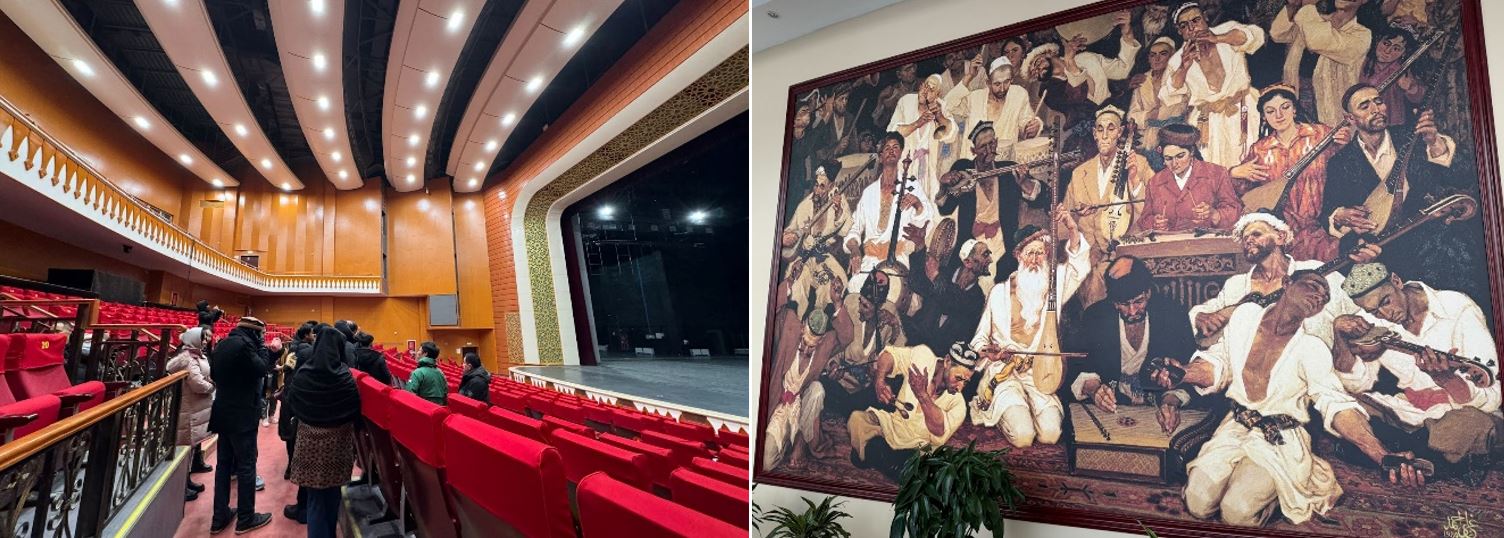
Xinjiang Medical University: A Beacon of Education and Inclusion
Our next stop was Xinjiang Medical University, which stood as a beacon of educational excellence and cultural inclusivity. Founded in 1956, the university was a hub of medical innovation and learning with its four campuses and nine affiliated hospitals. We were happy to see students from Pakistan indulging in their PhD studies at the campus, some of those who also graciously welcomed us to the university.
As I walked through the campus, I was struck by the diversity of the student body and architecture. With over 18,000 students, including 150 PhD candidates and 600 international students, the university was a microcosm of the world. The collaborations with various international medical bodies and the eligibility of its graduates for global medical certifications like USMLE and PLAB were a testament to its global outreach and standard of education. The architecture of the building was also deeply sophisticated and open. We witnessed open floor layouts that stretched over 5 stories, and also received a national award for best interior design across many different Universities.
What truly stood out was the emphasis on preserving ethnic cultures and languages, with broadcasts in multiple languages and a strong commitment to promoting ethnic studies. This approach to education, one that respects and integrates cultural diversity, is a model for universities worldwide.
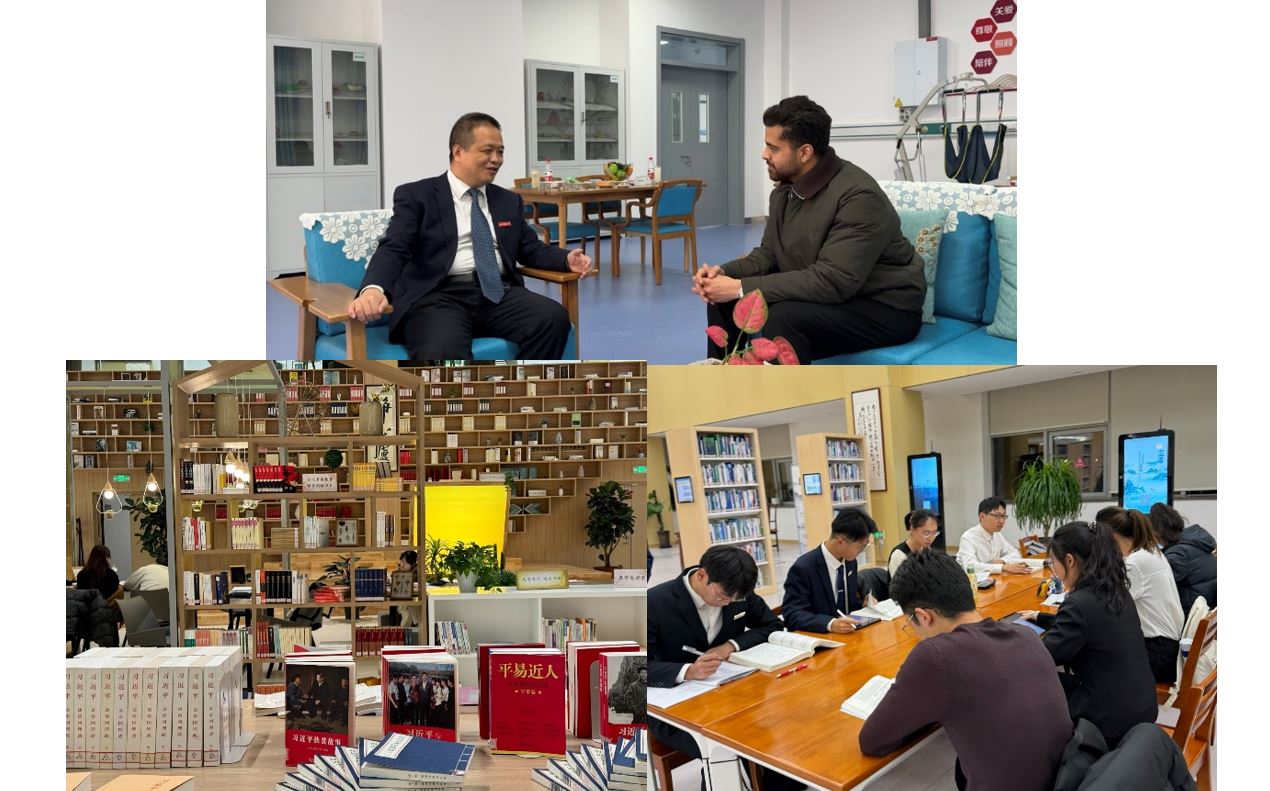
Xinjiang Islamic Institute: A Tribute to Religious Freedom
As the dawn of December 14th broke over Urumqi, I found myself in a city that was a crossroads of cultures and a beacon of religious and educational harmony. Our first stop was the Xinjiang Islamic Institute. Here, I had the privilege of speaking with Sheikh Abdul Raqeeb, the Institute’s President. His words painted a picture of an institution deeply committed to the education of Islamic principles, Chinese law, and history. With around 1000 students, the institute was a thriving learning centre, debunking any notion of a ban on practising Islam in Xinjiang and China.
What struck me was integrating religious education with societal and legal knowledge, preparing students not just for religious roles but for contributing positively to the broader society. Sheikh Raqeeb’s outright dismissal of the allegations against religious freedom in Xinjiang was a powerful counter-narrative to the stories often heard in the West.
The respect and protection of religious freedom, as articulated by Sheikh Raqeeb, was reflected in the policies and practices of the Chinese government. The provisions in the Chinese Constitution ensuring freedom of religious belief and the state’s role in protecting normal religious activities resonated deeply with me.
The arrangements made by the China Islamic Association for pilgrimages to Mecca, the publication of Islamic texts in multiple languages, and the unimpeded operation of halal restaurants during Ramadan were tangible examples of religious freedom.
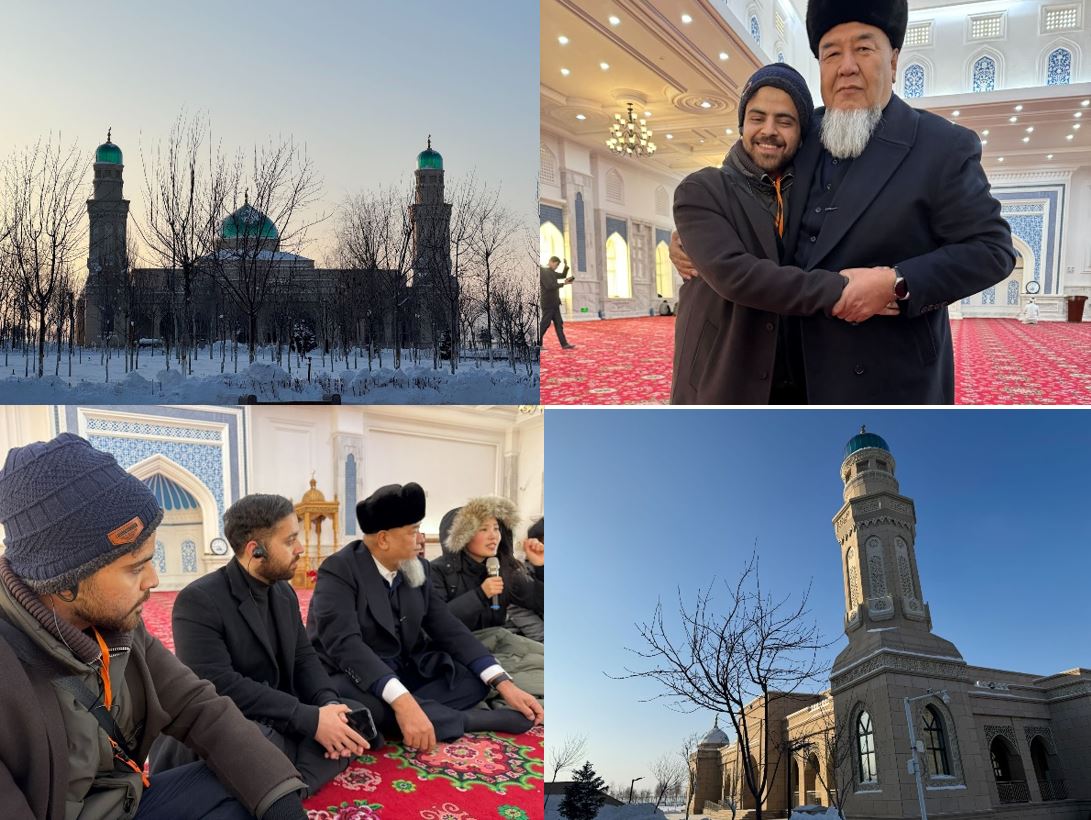
Improved Facilities and Training for Islamic Clerics:
The investment in religious venues was another aspect that caught my attention. Government funds allocated for the maintenance and renovation of mosques and improving facilities at these venues spoke volumes about the commitment to providing a conducive environment for religious practices.
The training system for Islamic clerics, especially with the government’s investment in building a new campus for the Xinjiang Islamic Institute, underscored the importance placed on religious education. The existence of multiple institute branches across the region highlighted the accessibility and depth of this education system.
Xinjiang International Convention and Exhibition Centre: From Turbulence to Tranquility
On a crisp December 15th morning, our delegation arrived at the Xinjiang International Convention and Exhibition Centre, poised to understand the depths of China’s approach to counter-terrorism in Xinjiang.
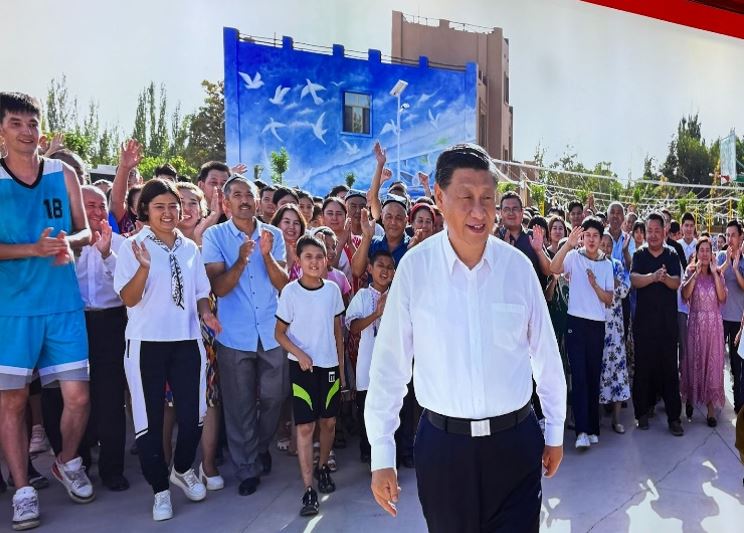
The ‘Theme Exhibition’ at the institute in Urumqi was our first stop. Here, a narrative unfolded that was both harrowing and enlightening. The exhibition detailed the turbulent period from 1996 to 2016 when Xinjiang grappled with extremist violence. The displays of recovered weapons and explosives were stark reminders of the challenges faced.
The tragic stories of targeted religious figures like Akmusjid Aji and Yunus Sdk highlighted the brutal impact of terrorism on innocent lives. These incidents were not isolated tragedies but part of a disturbing pattern of violence fueled by external ‘East Turkestan’ forces.
The narrative shifted from challenge to response as we moved through the exhibition. It became clear that China’s approach to counter-terrorism in Xinjiang was multi-faceted. The emphasis was on law-based counter-terrorism efforts, combined with policies addressing the root causes of extremism.
The ‘Theme Exhibition’ underscored China’s concern about foreign involvement in terrorism. The evidence of materials used in terrorist activities recovered in operations highlighted the complexity of the security challenges faced by China in the region.
The exhibition painted a picture of Xinjiang that has undergone profound changes. According to the material displayed, Xinjiang has seen a significant transformation following President Xi Jinping’s directives. The narrative was one of a region that now enjoys stable economic growth and social stability, a stark contrast to the turbulent past.
Xinjiang’s geographical location, bordering eight countries, adds to its strategic importance and complexity. The region, home to 56 ethnic groups and multiple religions, is a testament to China’s commitment to ethnic and religious diversity. With 24,800 places for religious activities, the statistics spoke of a region where religious freedom is not just protected but is thriving.



